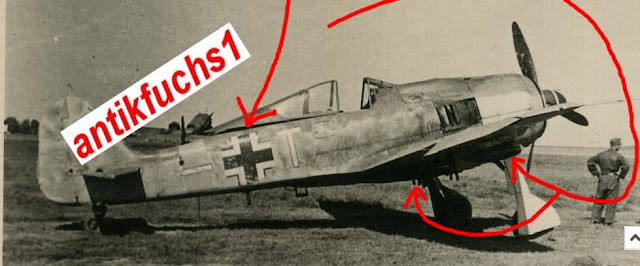My second 72nd scale Revell Me 262 in a week! Using Xtracolor and WEM Luftwaffe enamels in 82 and 83 this one is finished as one of the 'striped' machines flown by Maj. Rudolf Sinner of the Stab III./JG 7 'Green 1' (note the German-language caption in the Radinger/Schick book extract below states 'Red 1' ) toting twin 21 cm W.Gr. rocket launchers which were tested at Brandenburg-Briest but were no doubt a complete waste of time on such a fast machine as this.
Note the JG 7 fuselage bands, the III. Gruppe bar in black (white outline) and the white
Hakenkreuz - none of these markings features were visible on the first photo of Sinner's machine 'discovered' - and illustrated by J. Crandall for the Schiffer edition of M. Boehme's JG 7 history. It wasn't until A. Urbanke's LiF 'special' revealed details of Sinner's other striped machine (without the rocket launchers) that modellers could assume with a fair degree of certainty that this particular aircraft featured them.
Note the stripes extend over the tail of the aircraft; the T. Tullis profile in the Classic Me 262 Volume 3 has the tail and rear of the fuselage mottled. I used the decals from the Kagero ' Messerschmitt Me 262 - in Defence of the Reich' booklet although they appear a little on the small side to me - I took the Gruppe emblems from an Aeromaster sheet.
Hasegawa have just re-released this aircraft in 1:72nd scale - rather bizarrely the Hasegawa box-art for this machine features a view of the lower surfaces - the artist evidently not prepared to commit to a rendition of the upper surfaces 'stripes' perhaps or merely a device to emphasis the 'highlight' of this 'limited edition' kit, the white-metal rocket launchers? Whatever, list price at Hannants is a prohibitive £33 ! Hasegawa painting instructions opt for the 81/82 combination with Braunviolett but the LiF article on Sinner's striped 262s recommends the two greens finish as per my model here. In-box look at this kit on britmodeller
here
Rudi Sinner enjoyed most success in aerial combat with JG 27 serving in North Africa. He claimed his first victory on 12 October 1941, when he shot down a RAF P-40 near Sidi Omar.
On 4 June 1942, Sinner was appointed Staffelkapitän of 6./JG 27. On 10 June, Oberleutnant Sinner was shot down near Bir Hacheim by the British Ace, Charles Overton (5.5 confirmed, 1 probable and 0.5 damaged victories), flying a Spitfire Vb fighter of 145 Squadron RAF. Then, on 24 June, Sinner’s aircraft was hit in the engine during combat with RAF Hurricane fighters and he was forced to make an emergency landing. Sinner recorded his 10th victory on 13 July and his 20th on 24 July. On 31 August, Sinner shot down a Hurricane near Alam el Haifa. His victim was South African Ace, John “Harry” Gaynor (5.5 destroyed and 6 damaged victories) of 1 Sqn, SAAF, who crash-landed unhurt. He claimed his 30th victory on 3 September. In June 1943, Hauptmann Sinner was appointed Gruppenkommandeur IV./JG 27 then based at Kalamaki, Greece. However, his stay with the unit was brief.
On 30 July 1943, Sinner was appointed Gruppenkommandeur of IV./JG 54, based on the Russian front, taking over from Hauptmann Erich Rudorffer (224 victories, RK-S). Sinner led the Gruppe until 10 February 1944. He added three further victories to his victory total during his time with the unit. In March 1944, Hauptmann Sinner became Gruppenkommandeur of III./JG 54 located on the Western front. On 6 March 1944, Sinner shot down a USAAF B-17 four-engine bomber for his 36th victory. However, his aircraft was hit by the bombers’ defensive fire and Sinner was badly wounded. He successfully baled out of his stricken Bf-109 G-6 (W.Nr. 410557) ‘2’. By 12 June 1944, Sinner was again serving with JG 27, based on the Invasion front in France, in command of I.Gruppe. He was to lead the Gruppe until 1 August 1944.

During early 1945, Sinner was appointed Gkr. III./JG 7 and quickly brought the Gruppe up to operational status. At this time his victory total stood at 36, including 32 victories achieved over North Africa.
Sinner was to add three confirmed victories to his tally flying the jet, including two USAAF B-24 four-engine bombers near Rathenow on 3 March. On 4 April, Sinner led seven other Me-262s off from Rechlin. Emerging from the clouds shortly after take-off, the flight was bounced by P-51 fighters of the 339th Fighter Group. In the ensuing combat ‘Rudi’ Sinner’s aircraft was hit. With his face and hands badly burned, he baled out at low level. His parachute deployed at the last moment and failed to open fully so that he hit the ground heavily and was dragged into a barbed wire fence. He reported that the P-51s then attempted to strafe him. Sinner’s wounds were serious enough to keep him out of the rest of war.


Rudolf Sinner was credited with 39 victories in 305 missions. 36 of his victories were achieved over the Western front, including three four-engine bombers and three flying the Me 262 jet fighter. Three victories were achieved over the Eastern front. He was shot down 12 times, baling out on three occasions, and was wounded five times.




















































